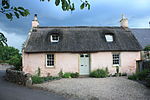Cairnie Hill

Cairnie Hill lies at the eastern end of the Ochil Hills, above the village of Collessie Scotland. It is the highest point of a small upland area between Collesie Den and Collairnie Farm. The northern and western slopes of Cairnie Hill are quite steep and are used for rough grazing and forestry. To the south the land rises gradually from the flat Howe of Fife and is used predominantly for arable farming. Cairnie is a common place name in Fife, possibly originating from the Pictish Carden or thicket, with the addition of the Gaelic ending aigh. It is also Scots for 'hillock'. An easy route to the summit starts at NO 273153, on the B937 about 2 km south of Lindores. From here a track leads up onto the summit area, from where several paths lead to the summit.
Excerpt from the Wikipedia article Cairnie Hill (License: CC BY-SA 3.0, Authors, Images).Cairnie Hill
Geographical coordinates (GPS) Address Nearby Places Show on map
Geographical coordinates (GPS)
| Latitude | Longitude |
|---|---|
| N 56.3264 ° | E -3.1675 ° |
Address
Collessie
KY15 7RQ
Scotland, United Kingdom
Open on Google Maps






